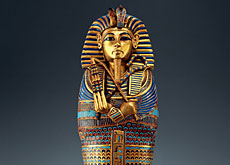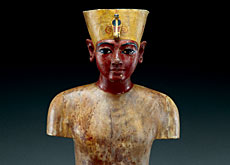Pharaoh’s glories come to Basel

The most important exhibition of ancient Egyptian artefacts to be seen in Europe for over 20 years has opened in Basel.
“Tutankhamun – the Golden Beyond” has over 50 pieces from the tomb of the mysterious boy pharaoh, as well as a further 70 items, many of which have never been seen before outside Egypt.
The exhibition is the result of long years of negotiation by the curators of Basel’s Museum of Antiquities, who had to persuade the Egyptian authorities to overrule a parliamentary vote forbidding the loan of Tutankhamun’s tomb relics to other countries.
“When we first went to Egypt they told us to forget it,” museum director Peter Blome told swissinfo. “They said ‘ask for something else, but don’t come here asking for Tutankhamun’.”
But Blome’s persistence paid off, together with the support of Zahi Hawass, president of Egypt’s Supreme Council of Antiquities.
“I am in favour of sending these pieces abroad,” said Hawass. “Because every time an exhibition about ancient Egypt opens, even a tiny exhibition, I see the wonder, and the passion of the visitors.”
Egyptian mystery
The last time an exhibition of this magnitude was seen in Europe was in Berlin in 1980. But that exhibition, and the famous London show of 1972, focused almost entirely on the mystery of the boy pharaoh Tutankhamun himself.
The Basel exhibition takes a broader view. As well as over 50 relics from Tutankhamun’s tomb, there are pieces from other royal tombs, and the tombs of high-ranking members of the court.
“We wanted to show Tutankhamun in a wider context,” explained chief curator André Wiese. “So we have included other tomb relics from the period 14th to 15th centuries BC.
“We have made comparisons, and we can say that Tutankhamun’s tomb is representative of royal tombs of that period,” Wiese told swissinfo.
The exhibition is indeed a stunning illustration of the effort and artistic skill that went into preparing the luxurious tombs, whose contents were designed to speed the dead into the afterlife.
As well as relics from Tutankhamun, there is an ornately carved chair belonging to Princess Satamun, a graceful wooden unguent spoon, and even a painted leather collar once worn by a royal hunting dog.
Tutankhamun’s reputation
Despite Tutankhamun’s reputation as having the most luxurious tomb of all, many of its contents were not in fact originally designed for him.
The young pharaoh died mysteriously at the age of only 17; preparations for his tomb had scarcely begun, so many of his funeral items were in fact hastily borrowed from older members of the royal family who were still alive.
The exhibition, which will last six months, is expected to attract at least half a million visitors.
And contrary to rumours in the press, there is no shortage of tickets. However, visitors will be expected to state not only a day, but also a specific time at which they intend to come to the museum.
Egypt has received SFr5 million ($3.86 million) for loaning the exhibits – the money will go towards building a new museum in Cairo.
And the pieces have been insured for around SFr840 million, although, as Blome pointed out “it is impossible to put a price on such items”.
Legendary curse
One aspect of ancient Egypt which the exhibition does not address is the legendary curse of the pharaohs, which apparently dooms all those who dare to disturb their tombs.
But Zahi Hawass, who has excavated many tombs himself, had a light-hearted answer to that question.
“On the entrance to one tomb I excavated, there was a carving which said ‘anyone who disturbs my tomb will be eaten by a crocodile, a hippo, and a lion’,” he said.
“So now I talk to the pharaohs – and they tell me that if Peter Blome damages any of these exhibits, the curse will be upon him.”
In fact Egypt is hoping that the exhibition in Basel will bring not only money for the much needed museum construction, but increased numbers of tourists to Egypt itself.
And chief curator André Wiese is so delighted by the very fact of staging the exhibition at all, that he has little time to think about curses.
“It’s a dream come true,” he said. “There were moments in Cairo when I just thought we would go back to Basel empty handed.”
“But now all these wonderful pieces are here – we finally made it.”
swissinfo, Imogen Foulkes in Basel
Tutankhamun – the Golden Beyond, is the biggest exhibition of ancient Egyptian art in Europe for over 20 years.
50 pieces come directly from Tutankhamun’s tomb, a further 70 from the tombs of other members of the royal family or high-ranking followers.
Egypt has received SFr5 million as a fee for loaning the exhibits.
Half a million people are expected to visit the exhibition.

In compliance with the JTI standards
More: SWI swissinfo.ch certified by the Journalism Trust Initiative









You can find an overview of ongoing debates with our journalists here . Please join us!
If you want to start a conversation about a topic raised in this article or want to report factual errors, email us at english@swissinfo.ch.